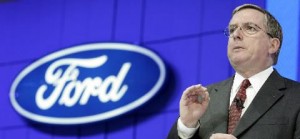
It will take great product, as well as cost-cutting to yield a sustainable turnaround, cautions Booth.
Though the US Senate is poised to provide more money for the popular cash for clunkers program, Ford Motor Company isn’t ready to commit to raising production just yet.
Ford Chief Financial Officer Lewis Booth told TheDetroitBureau.com that the federal incentives, which range up to $4,500 have made it difficult to forecast demand in an industry that has been operating at its lowest levels in three decades. The challenge is to decide whether there will be a short-term blip, or a longer-term boost that would require Ford to increase production, the executive said, during a dinner at the annual Management Briefing Seminars, in Traverse City, Michigan.
“We’re not going to complain about a program that helps people buy cars,” Booth said. But it has made planning more difficult because Ford and others in the industry are still unsure if the increase in demand is only a temporary spike in response to the government incentives or the start of more sustained increase in sales.
Booth also said that Ford intends to flex its “revenue muscle” in the future. The key to Ford’s future success is getting more money for every unit it sells, he explained. However, the ability to command higher prices depends is “sustained by a continuous flow of new products,” he said.
“Work on the cost side will only take you so far. You also have work on the pricing side.”
A test of both will come this year with the rebirth of the Taurus, once the best-selling midsize sedan in America, but now returning in the form of a larger, and more expensive, four-door.
“We’re selling more high-series cars and more options,” said Booth, who noted Ford’s relative success this year has included steady sales of the company’s most expensive pickup truck models. Preliminary demand for the 2010 Taurus SHO, the most expensive version of the new Taurus, also has been very strong.
In Europe, the success of the Ford Fiesta is an example of building the best product available in every segment.
“We’re having a fabulous year with Fiesta. It’s the best-selling car in the (United Kingdom.) It’s the second best selling car in Europe and it’s the best-selling car in the B (or subcompact) segment,” said Booth, who was in charge of Ford of Europe before becoming the automaker’s CFO, last fall.
“This isn’t about staying the course. It’s about prospering after the downturn,” he said. “My job is to make sure we have the proper balance of resources to protect our future,” he said.
Booth declined to say whether he agreed with the assessment from a top analyst that Ford could be profitable again by the end of the year. He didn’t exactly deny it either, though the CFO cautioned that his company had not changed its official financial guidance.
In the second quarter of 2009, Ford had a $424 million loss, and negative cash flow of $1 billion dollars. Ford’s second quarter revenue was $27.2 billion, down $11 billion from the same period a year ago. The 2011 financial targets, based on Ford’s current planning assumptions, are that overall and North American Automotive pre-tax results will be breakeven or better, excluding special items, and Automotive operating-related cash flow will be breakeven or better.
Booth did say Ford is capable of making a profit on small cars, long a market segment where Detroit makers were routinely expected to lose money. The formula includes global platforms capable of being tailored for specific markets and using the scale provided by the use of global, rather than regional, product platforms to hold down the cost of various components, while also using common parts in various models to help contain costs.
Ford’s strategy has been distilled from a series of successful turnarounds at the company’s operations in South Africa, Europe, and at Mazda, the Japanese maker it has long partnered with.
“You have to manage your costs very carefully,” concluded Booth. You also have to bring out cars that are (more than) competitive because the competition will have moved on. You also have to bring out cars that beat the competition. Great cars are not just about satisfying rational attributes. It’s about rational and emotional attributes,” he said.
